版权所有:内蒙古大学图书馆 技术提供:维普资讯• 智图
内蒙古自治区呼和浩特市赛罕区大学西街235号 邮编: 010021

作者机构:National Engineering Research Center for Big Data Technology and SystemServices Computing Technology and System LabCluster and Grid Computing LabSchool of Computer Science and TechnologyHuazhong University of Science and Technology
出 版 物:《Science China(Information Sciences)》 (中国科学:信息科学(英文版))
年 卷 期:2025年第68卷第2期
页 面:103-119页
核心收录:
学科分类:12[管理学] 1201[管理学-管理科学与工程(可授管理学、工学学位)] 081203[工学-计算机应用技术] 081104[工学-模式识别与智能系统] 08[工学] 0835[工学-软件工程] 0811[工学-控制科学与工程] 0812[工学-计算机科学与技术(可授工学、理学学位)]
基 金:supported in part by National Key R&D Program of China (Grant No. 2020AAA0108501) Major Program (JD) of Hubei Province (Grant No. 2023BAA024)
主 题:knowledge graph reasoning temporal knowledge graph Hawkes process semantic evidence
摘 要:Temporal knowledge graph(TKG) reasoning, has seen widespread use for modeling real-world events, particularly in extrapolation settings. Nevertheless, most previous studies are embedded models, which require both entity and relation embedding to make predictions, ignoring the semantic correlations among different entities and relations within the same timestamp. This can lead to random and nonsensical predictions when unseen entities or relations occur. Furthermore, many existing models exhibit limitations in handling highly correlated historical facts with extensive temporal depth. They often either overlook such facts or overly accentuate the relationships between recurring past occurrences and their current counterparts. Due to the dynamic nature of TKG, effectively capturing the evolving semantics between different timestamps can be *** address these shortcomings, we propose the recurrent semantic evidenceaware graph neural network(RE-SEGNN), a novel graph neural network that can learn the semantics of entities and relations simultaneously. For the former challenge, our model can predict a possible answer to missing quadruples based on semantics when facing unseen entities or relations. For the latter problem, based on an obvious established force, both the recency and frequency of semantic history tend to confer a higher reference value for the current. We use the Hawkes process to compute the semantic trend, which allows the semantics of recent facts to gain more attention than those of distant facts. Experimental results show that RE-SEGNN outperforms all SOTA models in entity prediction on 6 widely used datasets, and 5 datasets in relation prediction. Furthermore, the case study shows how our model can deal with unseen entities and relations.